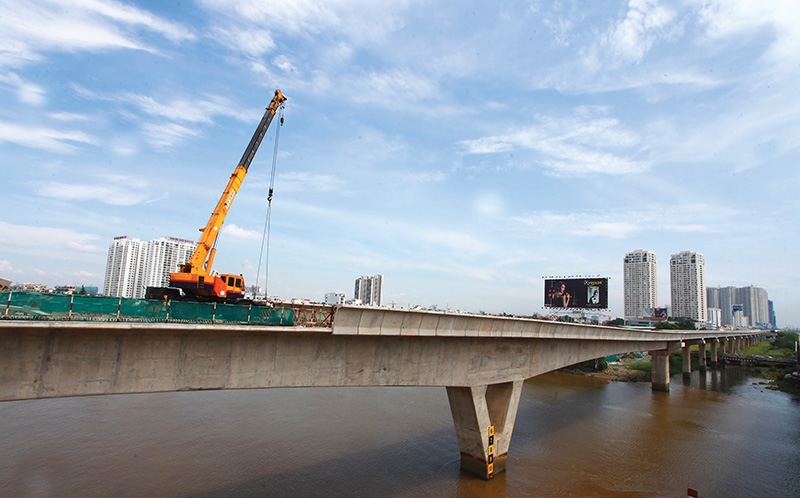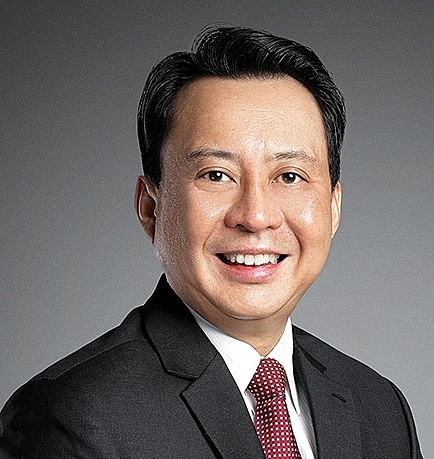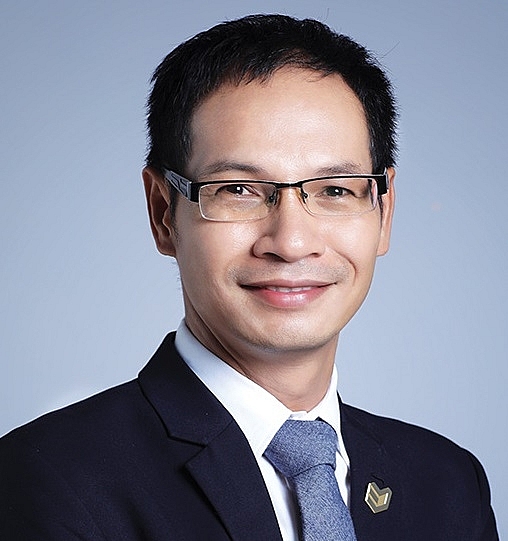East Ho Chi Minh City development ramps up
 |
| Ho Chi Minh City’s first metro line is expected to be completed by the end of 2021, photo Le Toan |
The city’s metro line 1 will stretch to 19.7km of a mass transit line connecting Ben Thanh Station in District 1 to Long Binh Depot in District 9, and is due to be completed by the end of 2021.
Since construction of the route began in 2012, many residential and retail developments have been built adjacent to the line, particularly along Hanoi Highway at Thao Dien, Binh An, and An Phu wards in District 2.
Metro line 1 is expected to be 85 per cent complete by the end of this year with operations scheduled to commence in the fourth quarter of 2021. Once completed the line will connect the eastern area to central business districts and is expected to lead to significant additional price growth.
Projects within walking distance of metro line 1 are hoped to attract strong demand from young professionals and families. Strong demand and premium prices for modern homes is also expected for this area.
The east of Ho Chi Minh City contains another magnet for real estate development in Thu Thiem New Urban Area, which covers nearly 700 hectares in District 2.
Thu Thiem will be one of the more vibrant areas with a substantial pipeline of commercial and high-end condominium projects expected to be built.
Large-scale projects include Empire City, funded by a joint venture from Tien Phuoc Real Estate JSC, Tran Thai Real Estate JSC, and two foreign investors – Corredance Pte. of Singapore and Denver Power from the British Virgin Islands; Lotte Groups’ Eco-smart City; Sunshine Sky Garden invested in by Sun Group; and Sala Urban Area from Dai Quang Minh.
Along with that, the recent proposal from Ho Chi Minh City authorities to combine districts 2, 9, and Thu Duc into a new city, provisionally called Thu Duc city, is considered a remarkable turning point for the city’s development as a whole.
Prices and interest hike up
Designed to become an innovative hub, the future Thu Duc city will attract both domestic and foreign investment into interactive technology, high-tech manufacturing, fintech, academia and research, and health and wellness.
Located across an area of 21,000ha, Thu Duc city is estimated to make a contribution of 30 per cent of the regional GDP for Ho Chi Minh City, or around 4-5 per cent of the country’s GDP.
Deputy Prime Minister Truong Hoa Binh last week requested the city committee to collect opinions from overseas investors and developers on their demands for investment in the future city.
To attract funding, Ho Chi Minh City authorities were requested to highlight the differences between Thu Duc and other financial and high-tech cities in the Asian region.
Research in several markets worldwide has found that residential properties within walking stations typically command higher selling prices than those that are not. A price premium often emerges well before metro lines and stations are fully completed.
According to CBRE Vietnam, price growth in the east of the city, especially in District 2, began to accelerate after the active construction of metro line 1. Over the last five years, residential sale prices in the district increased by an average of 7.3 per cent per year for the high-end segment, well beyond the citywide average and with significant potential for additional growth.
Since 2018, capital gains on the secondary market have been considerable as the metro line nears completion, with current asking prices 25 to 75 per cent higher than launching prices.
CBRE moreover expects that primary prices for new residential projects in the east will increase by around 20 per cent in the coming years while prices for those new projects along the metro line could increase by 40 per cent.
An expert from DKRA Vietnam told VIR that the increase in real estate prices near the metro stations is understandable and suitable to the development of a market, as seen in the past in developed countries such as Singapore, Malaysia, and Thailand.
“In the proposal to establish Thu Duc city, when transport infrastructure projects are being invested in, the price is also increased accordingly. Especially, the price increase is seen clearly in projects near the metro station,” said the source.
This price increase comes from the value added when these projects can offer more convenient transport conditions for citizens.
“The proposal to establish Thu Duc city is a catalyst for the development of real estate in the east and also in areas where the upcoming metro routes will pass,” the source said.
Future possibilities
Residential supply in the eastern area of Ho Chi Minh City is expected to grow at an annual rate of 11.5 per cent between 2020 and 2025, equivalent to 15,000-16,000 new units per year on average and exceeding the southern area with 4.6 per cent and the west area with 5.3 per cent.
Accommodation platforms such as Airbnb have already recorded rapid growth offering rentals in existing condominiums, and projects around stations along metro Line 1 in Binh Thanh, Thu Duc, and Saigon Hi-Tech Park.
Although completion of the route will provide a welcome boost, public transport in Ho Chi Minh City has yet to fully develop into an organised, connected, and holistic system capable of catalysing significant real estate prices, demand, and development growth.
Experts agree that it would also take time for the metro system to fully mature and for local people to become accustomed to using it. In addition, while infrastructure and connectivity are undoubtedly indispensable to supporting property market growth, the systematic development of residential and commercial real estate alongside supporting facilities and amenities will be essential to bringing the east of the city to life.
In terms of merging districts 2, 9, and Thu Duc, the concept of “a city inside a city” is a brand new one for Vietnam and, as a result, city authorities will have to embark into unknown territory. Challenges will likely involve enacting the correct policies and incentives for development, creating a synchronised zoning plan which can cover and harmonise between traditional and modern design, and ensuring social housing for local people who could be removed for new construction in the future.
| Caleb Lau - General manager, Hongkong Land Vietnam
The property value of a good property will increase over time, and further boosted by improvement of infrastructure connectivity and accessibility to amenities. The hype over the development of Thu Duc city proposal and upcoming metro line coming into operation will attract property developers to invest development in this new urban area. Besides that, land speculators will too be attracted to this investment opportunity. Therefore, a hike in land value in proposed Thu Duc city especially properties with close proximity to metro stations are expected. However, the real long-term land value will come from the eventual development in this new urban area. If land speculators continue to push land price higher and higher, property developers will have to acquire land at higher cost. This will increase the property development cost and developers will have a huge challenge in maintaining its sale price. As a result, higher property development cost will translate to higher property sale prices. On the flipside, the products and sale prices of properties will depend on market demand and supply. At this moment, the current supply of new homes remained low while demand for new homes is growing steadily in tandem with growth of Vietnam economy. Hence, the real estate market outlook of the proposed Thu Duc city development looks promising. Truong An Duong - General manager of residential, Frasers Property Vietnam
As the completion of Thu Thiem Bridge in 2008 and Thu Thiem Tunnel in 2011, the eastern Saigon (districts 2, 9 and Thu Duc) residential market has grown up significantly for both supply and demand comparing with the whole city, which strongly support by two key infrastructures helping reduce travel time to this area. The eastern area quickly becomes hotspot of clients and investors, where they have a wonderful experience with capital gain at 2-digit number. We can’t deny that infrastructure plays an important role in property market, and as the matter of fact, the current movement of metro line 1 also the Thu Duc city proposal create a great impact on the market growth, the systematic development of residential and commercial real estate alongside supporting facilities and amenities will be essential to attract huge community for this area. The market by way of the operation of supply and demand, healthier demand will be the best guarantee for its price. Nguyen Hoang - Director, DKRA Vietnam
The current time is not too early to expect the real estate in the eastern area of Ho Chi Minh City to boom caused by the proposal to establish the “Thu Duc City”, because in fact, the real estate market has begun to recognise direct impacts. However, at present it is not possible to envision a “city in a city “concept. Meanwhile, only with the information of establishing a city in the east, many investors have utilise this opportunity to advertise and raise the value of their real estate project. This movement thereby make the price of real estate in the area in general increased. If the current situation continues, I fear that in the next five years, the east area of Ho Chi Minh City will become an urban area of wealthy people because the prices are becoming too high compared to general level of the city. Typically, although the market is now impacted by the Covid-19, buyers cannot find out any project which is offering the prise of less than VND40 million per square metre in this area. The highest price is now estimated at VND160 million per sq.m in some outstanding projects. |
What the stars mean:
★ Poor ★ ★ Promising ★★★ Good ★★★★ Very good ★★★★★ Exceptional
Related Contents
Latest News
More News
- PM orders investment model for North–South high-speed rail (December 22, 2025 | 17:43)
- First members of Danang International Finance Centre revealed (December 22, 2025 | 17:39)
- Securing capital and efficiency for Vietnam’s 2026-2030 growth ambitions (December 17, 2025 | 10:00)
- Driving double-digit growth through green and circular transformation in Vietnam (December 17, 2025 | 09:00)
- Vietnam bucking trend in the global M&A landscape (December 16, 2025 | 14:20)
- Vietnam’s green transition demands collective financial action (December 15, 2025 | 12:00)
- VIR workshop highlights capital and policy for sustainable development (December 15, 2025 | 11:00)
- National Assembly approves pilot mechanisms to accelerate major projects in Hanoi (December 12, 2025 | 11:29)
- Vietnam eases policy approval requirements, simplifies foreign and outbound investments (December 11, 2025 | 17:53)
- Unpacking new momentum in Vietnam’s M&A market (December 10, 2025 | 09:59)




 Tag:
Tag:




















 Mobile Version
Mobile Version